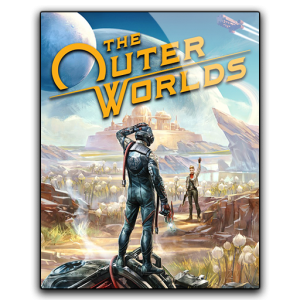The Outer Worlds is a first-person science fiction role-playing game. It was developed by the Obsidian Entertainment studio, a team whose portfolio includes productions such as Star Wars: Knights of the Old Republic II - The Sith Lords, Fallout: New Vegas or the Pillars of Eternity series. It was published by Private Division - under this brand Take-Two Interactive helps independent developers. Leonard Boyarsky and Tim Cain, the developers who led the work on the first part of the Fallout series, took care of this title. Inspirations for this series (and Fallout: New Vegas in particular) are clearly visible in The Outer Worlds. Set in the 24th century, The Outer Worlds presents a retrofuturistic vision of the future when mankind set out to conquer space, though its culture and technology are reminiscent of the 1940s. The action takes place in a distant colony in the Arkadia system (Halcyon), to which two ships with settlers have been directed. The player takes on the role of a crew member of the second of these units, which for unknown reasons went off course and disappeared for several dozen years, leaving thousands of hibernating settlers to their fate.
The adventure begins when the protagonist (or heroine) wakes scientist Phineas Welles from his long sleep. The protagonist (k)a learns that the colony, allegedly badly run by extremely bureaucratic corporations, is threatened with extinction and the only chance of being saved is to find a way to wake up the engineers and other specialists that make up the crew our ship came out of hibernation. Despite the situation outlined in this way, the player has a lot of freedom in shaping the situation in Arcadia and does not have to follow Welles. For example, nothing stands in the way of betraying a scientist and allying himself with corporations. So the adventure can end in many different ways. In The Outer Worlds, the story is shown only from the first person perspective (FPP). The driving force of the game are the main and side quests, which the hero can complete alone or with companions (one or two chosen out of six heroes) controlled by artificial intelligence. These characters, who join the protagonist throughout the adventure, have their own stories and motivations (related to separate similar missions), as well as individual abilities. However, there was no way to fall in love with companions. To get to know them better, it's worth speaking to them aboard the Unreliable starship, which is our base and mode of transport in Arkadia.

OS: Windows 7 (SP1) 64-bit.
CPU: Intel Core i3-3225 or AMD Phenom II X6 1100T.
RAM: 4GB.
GPU: Nvidia GTX 650 Ti or AMD HD 7850.
HDD: 40GB.
Although it can be said in advance that The Outer Worlds does not introduce any revolution to the genre, it must be admitted that the script can be interesting, although it is based on well-known cliches from related titles, sci-fi movies or books. The action takes place in the future, where humanity is colonizing new worlds, and large corporations have the right to buy and rule newly discovered star systems as they see fit. As a colonist, we board the Hope spacecraft, which is to take us to the Arcadia System within 10 years, wanting to start a new life. Unfortunately, the stay in space takes a long time, and when we wake up from hibernation, we find ourselves on the planet Terra 2, where we certainly did not expect such living conditions. As usual, we will try to survive and learn about our own destiny, weaving between greedy corporations and ordinary people who want to somehow survive in difficult conditions, avoiding various dangers or facing them.
How we do it depends on us. We can rebel against the existing reality, or cooperate with existing factions, or mix up a little bit of everything. Unfortunately, we will not only be able to play the hero flawlessly, for example in the Mass Effect series, because the plot, despite the relative non-linearity, makes us soak our hands in blood, often choosing between one evil and another. It's a pity, but the created universe is not a nice place, and all the characters understand it and they don't hold much of a grudge against us (apart from a handful of insults). Over time (if we want to), we will get a group of interesting companions with whom she will be able to enter into quite deep relationships, although romancing the opposite sex is almost impossible.
Nevertheless, congratulations to the creators that, despite the lack of originality, they created a fictional background where the border between good and evil is blurred, and each of the characters they meet has their reasons to do this and not otherwise. The dialogues in the game can be really long, we also get quite a lot of questions to choose from during the conversations, some of which are conditioned by the coefficients you have. In addition, a subtle dose of humor and harshness has also been smuggled in, so instead of talking dryly, our interlocutors can eat freely. Someone will find another anti-utopia, which we have already learned a lot, but good enough to be carried away by it. Depending on our style of play, we will spend up to 40 hours with the game, such a value does not make us crazy, but it is also not bad.